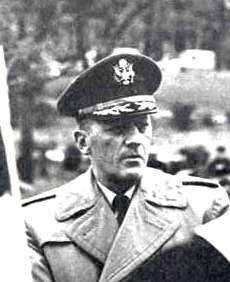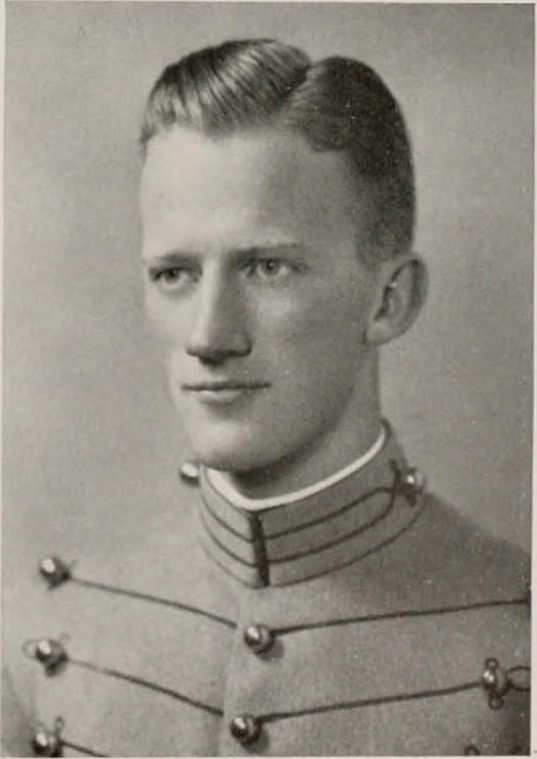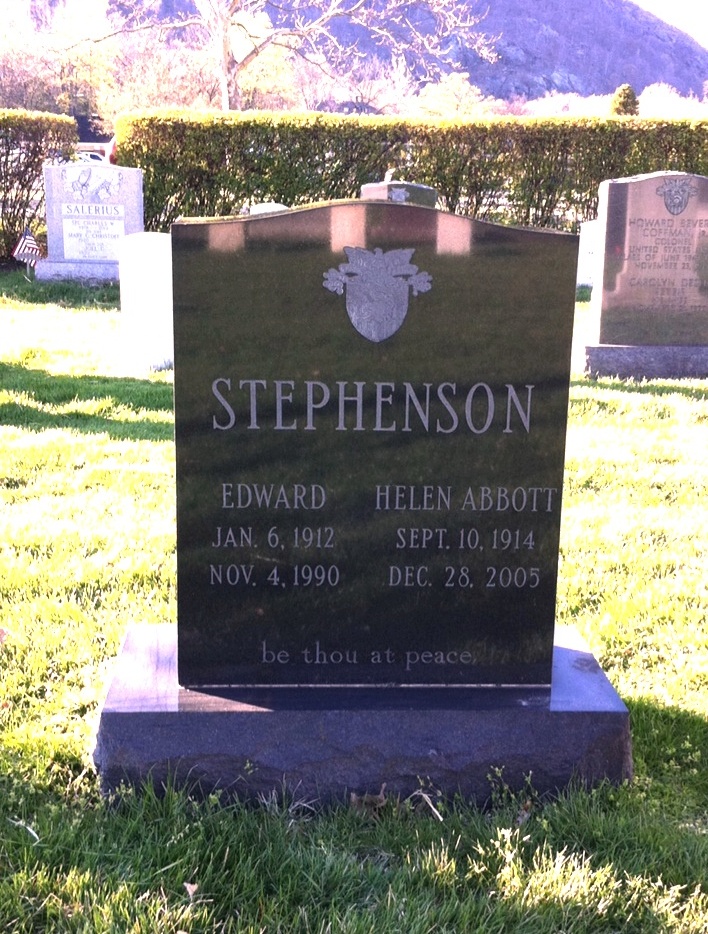Edward Stephenson, Sr. was born in Colombia, Missouri Saturday, January 6, 1912, the seventh of the eight children of William G. and Caroline Bennett Stephenson; he was the third of three brothers. He enjoyed a boyhood in Columbia Missouri, joining his two brothers in an enterprise involving (1) trapping muskrats during the winter months, and selling the pelts to Sears Roebuck & Co. and the carcasses to a local restaurant which put them on the menu as Marsh Rabbit (2) catching bullfrogs during the summer months, and selling the carcasses to the same restaurant to which they sold the muskrat carcasses and selling the skins to a local tannery which made fine leather from them.
He set his sights, early, on entering West Point, declining an appointment to Annapolis in favor of waiting for an appointment to West Point. In the interim before entering West Point with the class of 1936, he completed his Junior year at the University of Missouri where he was active in the Glee Club, among other activities. For reasons which can best be attributed to his prioritizing activities over academics, he was not able to graduate with the Class of 1936; but, graduated with the Class of 1938.
While at West Point, he distinguished himself for (1) having headed the Beast Detail his Yearling year (2) starring in the backfield of the 'Goat'football team in the annual Goat/Engineer football game(3) reorganizing, leading and directing the West Point Glee Club. He wrote music which endures in the West Point Glee Club repertoire to this day.
Post graduation, one of his deployments was to Fort Hamilton in Brooklyn New York, where he played on the Army Polo Team with his Brother William G. (Bill) Stephenson, USMA Class of 1925, who was also stationed there. While attached to General Omar Bradley's staff, at Fort Polk, during the Louisiana Maneuvers, he made a side trip to Little Rock Arkansas where he met Helen Abbott, who was with the Office of the State Auditor. They were married on April 19, 1942; and, together, raised three children: Edward Jr. (1-22-1943); Margaret Caroline (6-22-1945) and Anne Elizabeth (10-26-1957). His final post, prior to early retirement, was the Canal Zone (Panama). He encountered a tropical disease and was shipped to Walter Reed Hospital in 1942; where he mustered out of the Army.
Separating from the Army, a career to which he had dedicated himself since his young teens, was a blow of major proportions.Through his network of fellow officers with whom he had served, he was exposed to two opportunities which would allow him to apply his military skill sets directly to his new position; one at The Citadel in the Commandant’s Office and one at Culver Military Academy as Tactical Officer of Company ‘B’ and Instructor in College Algebra and Trigonometry. He chose Culver over the Citadel principally because the position at the Citadel required him to live in Barracks – not suitable for a man with a young family. Once at Culver, he joined the Indiana National Guard and rose swiftly to the rank of Colonel.
In 1951, he was appointed Assistant Commandant, the duties of which position absorbed his full attention; thus he gave up teaching. In 1954, it became apparent that Colonel W.E. Gregory, the then sitting Superintendent of Culver, was grooming him as his replacement. He was appointed as Executive Officer to replace Colonel Alan R. Elliot, who had retired; with the understanding that, at the end of one year of service as Executive Officer, he could return to the Commandant’s office if he so chose. In fact, he chose the Commandant’s office on the grounds that he preferred the daily contact with the Corps of Cadets to the business of running the School. Upon the retirement of Colonel C.F. McKinney, he was appointed Commandant of Cadets and remained in that position until 1965.
The untimely death of Colonel Gregory in 1956 at the age of fifty-four, marked a severe change of paradigm at Culver which resulted in a reduced significance of the office of Commandant of Cadets. During the ensuing nine years, the position devolved into a name only with no meaningful function; and, he moved into a minor executive position which he held until 1972 when he separated from Culver. His standing among the alumni of Culver, who knew him during their cadet years, speaks for itself.
His West Point Glee Club experience extended to singing second tenor in a quartet the other members of which were the Academy Surgeon, a Biology Instructor and a member of his Staff. Every Christmas, he organized and directed Christmas Carols for the neighborhood. He had a green thumb. While stationed in the Canal Zone, he planted fruit trees: Avocado; Kumquat; Lemon; Lime; and Orange.Once settled at Culver, he cleared the property, he bought, of its wilderness and planted several varieties of Apple trees. He also kept bees to pollinate the apples. He built a water garden , complete with water lilies, and other water plants as well as frogs and goldfish.
Upon separation from Culver, he bought two lots on St. Simons Island, Georgia and designed and built a home on the two lots. He planted the same array of fruit tress as he had planted in Panama. He became involved in community activities, chairing the local chapter of the Audubon Society. He took advantage of the proximity to the sea and spent many of his waking hours fishing.
It was on one of his fishing trips, in the early spring of 1990, that congestive heart failure caught up with him. During the nine months, beginning with March 1990, he became ever weaker and died on Sunday, November 4, 1990, two months prior to his seventy-ninth birthday.
Duty, Honor, Country - another joins the Long Grey Line!
Edward Stephenson, Sr. was born in Colombia, Missouri Saturday, January 6, 1912, the seventh of the eight children of William G. and Caroline Bennett Stephenson; he was the third of three brothers. He enjoyed a boyhood in Columbia Missouri, joining his two brothers in an enterprise involving (1) trapping muskrats during the winter months, and selling the pelts to Sears Roebuck & Co. and the carcasses to a local restaurant which put them on the menu as Marsh Rabbit (2) catching bullfrogs during the summer months, and selling the carcasses to the same restaurant to which they sold the muskrat carcasses and selling the skins to a local tannery which made fine leather from them.
He set his sights, early, on entering West Point, declining an appointment to Annapolis in favor of waiting for an appointment to West Point. In the interim before entering West Point with the class of 1936, he completed his Junior year at the University of Missouri where he was active in the Glee Club, among other activities. For reasons which can best be attributed to his prioritizing activities over academics, he was not able to graduate with the Class of 1936; but, graduated with the Class of 1938.
While at West Point, he distinguished himself for (1) having headed the Beast Detail his Yearling year (2) starring in the backfield of the 'Goat'football team in the annual Goat/Engineer football game(3) reorganizing, leading and directing the West Point Glee Club. He wrote music which endures in the West Point Glee Club repertoire to this day.
Post graduation, one of his deployments was to Fort Hamilton in Brooklyn New York, where he played on the Army Polo Team with his Brother William G. (Bill) Stephenson, USMA Class of 1925, who was also stationed there. While attached to General Omar Bradley's staff, at Fort Polk, during the Louisiana Maneuvers, he made a side trip to Little Rock Arkansas where he met Helen Abbott, who was with the Office of the State Auditor. They were married on April 19, 1942; and, together, raised three children: Edward Jr. (1-22-1943); Margaret Caroline (6-22-1945) and Anne Elizabeth (10-26-1957). His final post, prior to early retirement, was the Canal Zone (Panama). He encountered a tropical disease and was shipped to Walter Reed Hospital in 1942; where he mustered out of the Army.
Separating from the Army, a career to which he had dedicated himself since his young teens, was a blow of major proportions.Through his network of fellow officers with whom he had served, he was exposed to two opportunities which would allow him to apply his military skill sets directly to his new position; one at The Citadel in the Commandant’s Office and one at Culver Military Academy as Tactical Officer of Company ‘B’ and Instructor in College Algebra and Trigonometry. He chose Culver over the Citadel principally because the position at the Citadel required him to live in Barracks – not suitable for a man with a young family. Once at Culver, he joined the Indiana National Guard and rose swiftly to the rank of Colonel.
In 1951, he was appointed Assistant Commandant, the duties of which position absorbed his full attention; thus he gave up teaching. In 1954, it became apparent that Colonel W.E. Gregory, the then sitting Superintendent of Culver, was grooming him as his replacement. He was appointed as Executive Officer to replace Colonel Alan R. Elliot, who had retired; with the understanding that, at the end of one year of service as Executive Officer, he could return to the Commandant’s office if he so chose. In fact, he chose the Commandant’s office on the grounds that he preferred the daily contact with the Corps of Cadets to the business of running the School. Upon the retirement of Colonel C.F. McKinney, he was appointed Commandant of Cadets and remained in that position until 1965.
The untimely death of Colonel Gregory in 1956 at the age of fifty-four, marked a severe change of paradigm at Culver which resulted in a reduced significance of the office of Commandant of Cadets. During the ensuing nine years, the position devolved into a name only with no meaningful function; and, he moved into a minor executive position which he held until 1972 when he separated from Culver. His standing among the alumni of Culver, who knew him during their cadet years, speaks for itself.
His West Point Glee Club experience extended to singing second tenor in a quartet the other members of which were the Academy Surgeon, a Biology Instructor and a member of his Staff. Every Christmas, he organized and directed Christmas Carols for the neighborhood. He had a green thumb. While stationed in the Canal Zone, he planted fruit trees: Avocado; Kumquat; Lemon; Lime; and Orange.Once settled at Culver, he cleared the property, he bought, of its wilderness and planted several varieties of Apple trees. He also kept bees to pollinate the apples. He built a water garden , complete with water lilies, and other water plants as well as frogs and goldfish.
Upon separation from Culver, he bought two lots on St. Simons Island, Georgia and designed and built a home on the two lots. He planted the same array of fruit tress as he had planted in Panama. He became involved in community activities, chairing the local chapter of the Audubon Society. He took advantage of the proximity to the sea and spent many of his waking hours fishing.
It was on one of his fishing trips, in the early spring of 1990, that congestive heart failure caught up with him. During the nine months, beginning with March 1990, he became ever weaker and died on Sunday, November 4, 1990, two months prior to his seventy-ninth birthday.
Duty, Honor, Country - another joins the Long Grey Line!
Family Members
Sponsored by Ancestry
Advertisement
Advertisement











